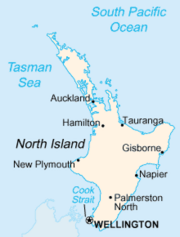North Island
 |
|
| Geography | |
|---|---|
 North Island (New Zealand)
|
|
| Location | New Zealand |
| Area | 113,729 km² (14th) |
| Highest point | Mount Ruapehu (2,797 m) |
| Country | |
| Largest city | Auckland (1,313,200) |
| Demographics | |
| Population | 3,250,700 (as of June 2008 estimate) |
| Density | 28.6 people/km2 |
The North Island is one of the two main islands of New Zealand, the other being the South Island.[1] The island is 113,729 square km in area[2], making it the world's 14th-largest island. It has a population of 3,250,700 (June 2008 estimate).[3]
Several important cities are in the North Island, notably New Zealand's largest city, Auckland, and Wellington, the capital, located at the southern extremity of the island. Approximately 76% of New Zealand's population lives in the North Island.[4]
According to Māori mythology, the North and South Islands of New Zealand arose through the actions of the demigod Māui. Māui and his brothers were fishing from their canoe (the South Island) when he caught a great fish and pulled it from the sea. While he was not looking his brothers fought over the fish and chopped it up. This great fish became the North Island and thus the Māori name for the North Island is Te Ika-a-Māui (The Fish of Māui). The mountains and valleys are said to have been formed as a result of Māui's brothers' hacking at the fish.[5]
Contents |
Regions of the North Island
Nine local government regions cover the North Island and all its adjacent islands and territorial waters.
- Northland
- Auckland
- Bay of Plenty
- Gisborne
- Waikato
- Taranaki
- Manawatu-Wanganui
- Hawkes Bay
- Wellington
Cities and towns in the North Island
(Smaller urban areas are found on the List of towns in New Zealand.)
- Auckland
- Cambridge
- Coromandel
- Foxton
- Gisborne
- Hamilton
- Hastings
- Huntly
- Kerikeri
- Matamata
- Masterton
- Napier
- New Plymouth
- Pahiatua
- Palmerston North
- Paraparaumu
- Porirua
- Raglan
- Rotorua
- Stratford
- Taupo
- Thames
- Tauranga
- Wellington
Geographic features
- Cape Reinga
- East Cape
- Cape Palliser
- Cook Strait
- Hikurangi Trench
- Lake Taupo
- Mt Maunganui Beach
- Tongariro National Park
- Taumatawhakatangihangakoauauotamateapokaiwhenuakitanatahu
- Waikato River
- Waipoua Kauri Forest
- Waitomo Caves
- Ninety Mile Beach
Notes
- ↑ On some 19th century maps, the North Island is named New Ulster, which was also a province of New Zealand that included the North Island.
- ↑ Statistics New Zealand Geography - physical features
- ↑ "Subnational Population Estimates: At 30 June 2008". Statistics New Zealand (23 October 2008). Retrieved on 2008-10-28.
- ↑ The definite article is used with the names of the North and South islands, as the North Island and the South Island, like the North Sea and the Western World, but unlike Rangitoto Island or West Point. Maps, headings or tables and adjectival expressions use North Island, whereas the North Island is used after a preposition or before or after a verb, e.g. my mother lives in the North Island, the North Island is smaller than the South Island, or I'm visiting the North Island. When specifying the island where a place, person, or object is located, it is normal to use the word in rather than on, for example Hamilton is in the North Island.
- ↑ Until the early 20th Century, an alternative Māori name for the North Island was Aotearoa. In present Māori usage, Aotearoa is a collective name for New Zealand as a whole.
|
||||||||||||||